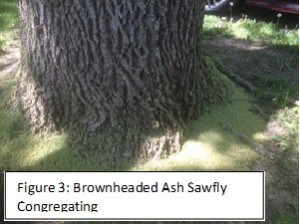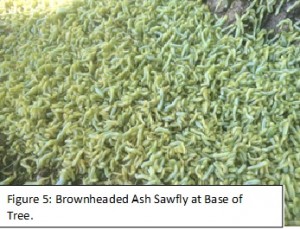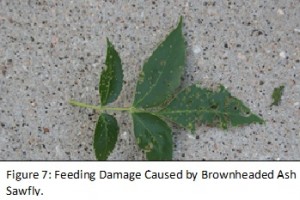–Dr. Raymond Cloyd
We continue to receive inquires throughout the state regarding green ash (Fraxinus pennsylvanica) trees being fed upon by populations of the brownheaded ash sawfly, Tomostethus multicinctus. This is a sporadic, early season, defoliating insect pest that appeared in Manhattan, KS in 2013. Populations feed extensively causing noticeable foliar damage and producing lots of frass (sawfly poop).
Brownheaded ash sawfly larvae, which resemble caterpillars, are 15 to 20 mm long and yellow-green in color with white and green stripes extending the length of the abdomen or back (Figures 1 and 2). They possess a brown head, and have prolegs on every abdominal

segment with no crochets or hairs on the feet, which distinguishes them from caterpillars. Brownheaded ash sawfly larvae feed primarily on ash trees (green and white) (Figure 3).
Brownheaded ash sawfly pupates in the spring, with adults, which are wasp-like in appearance, emerging and females laying eggs inside leaves. Eggs hatch into larvae that congregate into massive groups at the base of trees (Figures 4 through 6), and feed from May through June. The larvae create shot-hole or pin-hole damage on leaves when young (Figure 7), but as they increase in size, the larvae consume entire leaves, especially terminal leaves (except the main veins), resulting in almost complete defoliation. The larvae are full-grown by June and shed a paper-like skin that is attached to the leaf (Figure 8). Larvae then migrate toward the base of the tree, enter the soil, and form a protective cocoon. Brownheaded ash sawfly overwinters as a full-grown larvae or pre-pupae within silken-lined cells located in the top portion of the soil at the base of previously infested trees. High numbers may congregate at the base of trees. There is one generation per year.
In general, it is not warranted to spray an insecticide unless populations of brownheaded ash sawfly larvae are excessive and causing substantial damage to ash trees, which is contingent on the size or age of the tree. It is interesting to note that rainfall will quickly remove larvae from trees. In fact, a forceful water spray will dislodge larvae, which fall to the ground, and then are subsequently consumed by birds. If necessary, insecticides may be applied that contain the following active ingredients: acephate, bifenthrin, carbaryl, cyfluthrin, lambda-cyhalothrin, permethrin, petroleum oil (horticultural oil), potassium salts of fatty acids (insecticidal soap), and pyrethrins. These are all contact insecticides so thorough coverage of the tree canopy is important. Since this insect is a sawfly, insecticides such as Dipel or Thuricide that contain the active ingredient, Bacillus thuringiensis subsp. kurstaki will not be effective (refer to the previous issue of the newsletter). Be sure to assess the numbers of larvae present in order to determine if sufficient damage is occurring to justify the application of an insecticide.






